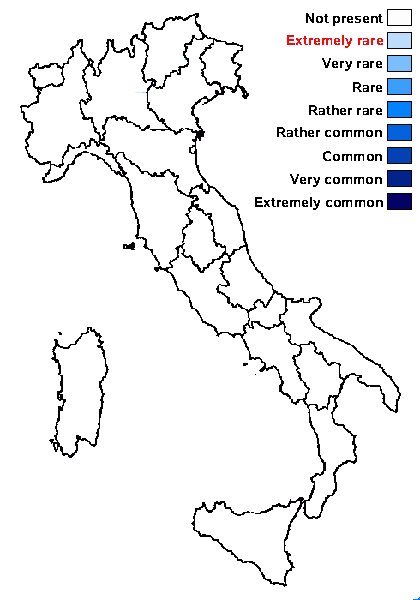Candelariella rubrisoli D. Liu & Hur
Mycobiology, 47: 41, 2019.
Synonyms: Candelariella xanthostigmoides auct. eur. non (Müll. Arg.) R. W. Rogers; Opeltiella rubrisoli (D. Liu & Hur) S. Y. Kondr.
Distribution:
Description: Thallus crustose, areolate, sorediate, the areoles often abundant, well-developed and somewhat lobulate, sometimes subsquamulose, scattered or aggregated, green to green-yellow, up to 0.35 mm wide, with a c.10 μm thick cortex consisting of 1-2 layers of more or less isodiametric cells. Soralia yellow-green (more yellow than the areoles), initially emerging from the margins of the areoles, 0.15-0.35 μm wide, at first convex, solitary and well delimited, then confluent but generally not forming large and continuous sorediate crusts. Soredia 20-50 μm in diam., composed of 5-15 photobiont cells surrounded by hyphae which often have a yellow-brownish pigment. Apothecia rare, lecanorine, scattered, 0.3-0.5 mm across, with a flat, yellow-orange disc, a smooth, entire, yellow proper margin, and a thin, green-yellow to yellow, irregular, finally excluded thalline margin. Thalline exciple c. 60 μm thick, with an indistinct paraplectenchymatous cortex; proper exciple 40-60 μm thick in upper part, of radiating hyphae; epithecium yellow-brown; hymenium colourless, 65-75 μm high; paraphyses simple or sparingly branched, 2-3 μm thick, the apical cells not or only slightly swollen; hypothecium colourless. Asci (4-)8-spored, clavate, with an apical dome which is I+ blue only in the internal, lower part, interrupted in the centre by a I+ paler blue strip, Candelaria-type. Ascospores 1-celled or rarely with a thin septum, hyaline, multiguttulate, narrowly ellipsoid, sometimes narrowing at one end, 11-18 x 5.5-7 μm. Photobiont chlorococcoid. Spot tests: K-, C-, KC-, P-. Chemistry: pulvinic acid derivatives. Note: a species described from China, and later found in several European Countries, sometimes treated by European authors as C. xanthostigmoides, which apparently does not occur in Europe. It grows on trunks and twigs of a wide range of tree species, both in open situations and within forests. Some Italian records could be hidden among those of C. reflexa. For further details see van der Kolk & al. (2025). To be looked for in Italy.
Growth form: Crustose
Substrata: bark
Photobiont: green algae other than Trentepohlia
Reproductive strategy: mainly asexual, by soredia, or soredia-like structures (e.g. blastidia)

Predictive model

Source: van der Kolk H-J, Westberg M, Malíček J. Morphological and molecular data support the distinction of four sorediate corticolous Candelariella species in Europe. The Lichenologist. 2025;57(3-4):144-165. doi:10.1017/S0024282925101059 - CC BY 4.0
Candelariella rubrisoli. A, van der Kolk 2914 (clade B). B, van der Kolk 3314 (clade unknown), with the pink lichenicolous fungus Illosporiopsis christiansenii. C, van der Kolk 3314 (clade unknown). D, van der Kolk 2707 (clade B). E, van der Kolk 3547 (clade B). F, van der Kolk 3569 (clade A). G, van der Kolk 3100 (clade A). Scales: A, B & D = 1 mm; C, E–G = 0.5 mm.
Growth form: Crustose
Substrata: bark
Photobiont: green algae other than Trentepohlia
Reproductive strategy: mainly asexual, by soredia, or soredia-like structures (e.g. blastidia)

Predictive model


